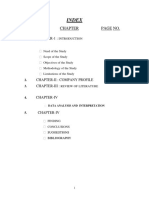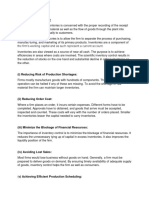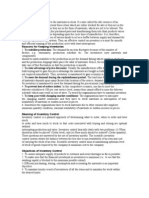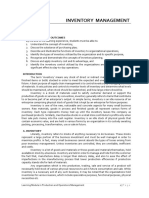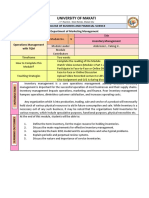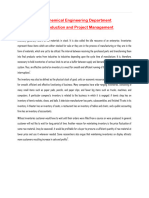ACCM01B - Module 4
Uploaded by
julianronato73ACCM01B - Module 4
Uploaded by
julianronato73MODULE 4
Costing and Pricing
SESSION TOPIC 4 : Inventory Management
LEARNING OUTCOMES:
The following specific learning objectives are expected to be realized at the end of the session:
1. Understand the definition inventory
2. Understand the types of inventory
3. Understand the definition inventory control
4. Understand the techniques of inventory control
KEY POINTS
Inventory Inventory Control Techniques of Inventory Model
Inventory Control
CORE CONTENT
Introduction:
This module covers the discussion of the definition inventory, types of inventory, reasons for keeping inventories,
Definition of inventory control, objectives of inventory control, benefits of inventory control, techniques of inventory control
and the Economic Order Quantity (EOQ) Model.
IN-TEXT ACTIVITY
Definition Inventory
Inventory generally refers to the materials in stock. It is also called the idle resource of an enterprise. Inventories represent
those items which are either stocked for sale or they are in the process of manufacturing or they are in the form of materials,
which are yet to be utilized. The interval between receiving the purchased parts and transforming them into final products
varies from industries to industries depending upon the cycle time of manufacture. It is, therefore, necessary to hold
inventories of various kinds to act as a buffer between supply and demand for efficient operation of the system. Thus, an
effective control on inventory is a must for smooth and efficient running of the production cycle with least interruptions.
Types of Inventory
1. Cycle Stock. These are also called lot size inventories. This is inventory for immediate use and is computed based on
expected demand over a certain time period. It assumes demand is known with certainty and computes how muc stock is
needed over a set period of time. It also accounts for the fact that products are typically produced in batches. This is the
quantity, or the size, of batch that is produced during the production cycle. Therefore it is called “cycle stock.”
2. Safety Stock. Also called buffer stock, is the extra inventory we carry to serve as a cushion for uncertainties in supply and
demand. It can be in the form of finished goods to cover unexpected demand. It can also be in the form of raw materials to
guard against supply problems, or int the form of WIP inventories, to guard against production stoppages.
3. Anticipation Inventory. These inventories are carried in anticipation of certain events. Their one purpose is to compensate
for differences in the timing of supply and demand, and to smooth out the flow of products through out the supply chain. They
are also used when demand fluctuations are significant, but predictable such as with seasonal variations.
Seasonal inventory - This is where companies carry extra inventory during a low season in anticipation of higher demands
during high season.
Hedge inventory - These are inventories that are carried in anticipation of price increase or shortage of products.
4. Pipeline Inventory. Also called transportation inventory, this is inventory that is simply in transit. It exists because the points
of demand and supply are not same.
ACCM01B Costing and Pricing / JC SISON 1
5. Maintenance, repair and operating items. In addition to inventories that directly support product creation, there are other
inventories that are used indirectly. These include everything from office supplies and forms, to toilet paper and cleaning
supplies, to tools and parts needed to repair machines.
Reasons for Keeping Inventories
1. To stabilize production: The demand for an item fluctuates because of the number of factors, e.g., seasonality, production
schedule etc. The inventories (raw materials and components) should be made available to the production as per the demand
failing which results in stock out and the production stoppage takes place for want of materials. Hence, the inventory is kept to
take care of this fluctuation so that the production is smooth.
2. To take advantage of price discounts: Usually the manufacturers offer discount for bulk buying and to gain this price
advantage the materials are bought in bulk even though it is not required immediately. Thus, inventory is maintained to gain
economy in purchasing.
3. To meet the demand during the replenishment period: The lead time for procurement of materials depends upon many
factors like location of the source, demand supply condition, etc. So inventory is maintained to meet the demand during the
procurement (replenishment) period.
4. To prevent loss of orders (sales): In this competitive scenario, one has to meet the delivery schedules at 100 per cent
service level, means they cannot afford to miss the delivery schedule which may result in loss of sales. To avoid the
organizations have to maintain inventory.
5. To keep pace with changing market conditions: The organizations have to anticipate the changing market sentiments
and they have to stock materials in anticipation of non-availability of materials or sudden increase in prices. Sometimes the
organizations have to stock materials due to other reasons like suppliers minimum quantity condition, seasonal availability of
materials or sudden increase in prices.
Inventory Control
Inventory control is a planned approach of determining what to order, when to order and how much to order and how much to
stock so that costs associated with buying and storing are optimal without interrupting production and sales. Inventory control
basically deals with two problems: (i) When should an order be placed? (Order level), and (ii) How much should be ordered?
(Order quantity). These questions are answered by the use of inventory models. The scientific inventory control system strikes
the balance between the loss due to non-availability of an item and cost of carrying the stock of an item. Scientific inventory
control aims at maintaining optimum level of stock of goods required by the company at minimum cost to the company.
Objectives of Inventory Control
1. To ensure adequate supply of products to customer and avoid shortages as far as possible.
2. To make sure that the financial investment in inventories is minimum (i.e., to see that the working capital is blocked to the
minimum possible extent).
3. Efficient purchasing, storing, consumption and accounting for materials is an important objective.
4. To maintain timely record of inventories of all the items and to maintain the stock within the desired limits.
5. To ensure timely action for replenishment.
6. To provide a reserve stock for variations in lead times of delivery of materials.
7. To provide a scientific base for both short-term and long-term planning of materials.
Benefits of Inventory Control
It is an established fact that through the practice of scientific inventory control, following are the benefits of inventory control:
1. Improvement in customer’s relationship because of the timely delivery of goods and service.
2. Smooth and uninterrupted production and, hence, no stock out.
3. Efficient utilization of working capital. Helps in minimizing loss due to deterioration, obsolescence damage and pilferage.
4. Economy in purchasing.
5. Eliminates the possibility of duplicate ordering
Techniques of Inventory Control
In any organization, depending on the type of business, inventory is maintained. When the number of items in inventory is
large and then large amount of money is needed to create such inventory, it becomes the concern of the management to have
ACCM01B Costing and Pricing / JC SISON 2
a proper control over its ordering, procurement, maintenance and consumption. The control can be for order quality and order
frequency.
The different techniques of inventory control are: (1) ABC analysis, (2) HML analysis, (3) VED analysis, (4) FSN analysis, (5)
SDE analysis, (6) GOLF analysis and (7) SOS analysis. The most widely used method of inventory control is known as ABC
analysis. In this technique, the total inventory is categorized into three sub-heads and then proper exercise is exercised for
each sub-heads.
1. ABC analysis: In this analysis, the classification of existing inventory is based on annual consumption and the annual value
of the items. Hence we obtain the quantity of inventory item consumed during the year and multiply it by unit cost to obtain
annual usage cost. The items are then arranged in the descending order of such annual usage cost.
Once ABC classification has been achieved, the policy control can be formulated as follows:
A-Item: Very tight control, the items being of high value. The control need be exercised at higher level of authority.
B-Item: Moderate control, the items being of moderate value. The control need be exercised at middle level of authority.
C-Item: The items being of low value, the control can be exercised at gross root level of authority, i.e., by respective user
department managers.
2. HML analysis: In this analysis, the classification of existing inventory is based on unit price of the items. They are classified
as high price, medium price and low cost items.
3. VED analysis: In this analysis, the classification of existing inventory is based on criticality of the items. They are classified
as vital, essential and desirable items. It is mainly used in spare parts inventory.
4. FSN analysis: In this analysis, the classification of existing inventory is based consumption of the items. They are classified
as fast moving, slow moving and non-moving items.
5. SDE analysis: In this analysis, the classification of existing inventory is based on the items.
6. GOLF analysis: In this analysis, the classification of existing inventory is based sources of the items. They are classified as
Government supply, ordinarily available, local availability and foreign source of supply items.
7. SOS analysis: In this analysis, the classification of existing inventory is based nature of supply of items. They are classified
as seasonal and off-seasonal items.
For effective inventory control, combination of the techniques of ABC with VED or ABC with HML or VED with HML analysis is
practically used.
Inventory Costs
1. Carrying Cost. Sometimes called holding cost, includes all costs that vary with the amount of inventory held in stock. This
includes storage facilities, handling, insurance, pilferage, breakage, obsolescence, depreciation, taxes and opportunity costs of
capital. Although we own the inventory, there are still costs associated with keeping it.
2. Ordering Cost. This cot includes all the costs involved in placing an order and procuring the item. It involves deciding on
order quantities, clerical costs involved in placing the order, tracking the order and receiving it. Ordering cost is sometimes
called set up cost as it also includes the costs involved in preparing the production run, when items are made in-house.
3. Shortage Cost. Temporary or permanent loss of sales when demand cannot be met. This is an opportunity cost for not
having inventory in stock that is resulting in loss of sales.
Inventory Model - The Economic Order Quantity (EOQ) Model
EOQ assumes that relevant costs of inventory can be divided into order costs and carrying costs
The EOQ model analyzes the trade-off between order costs and carrying costs to determine the order quantity that minimizes
the total inventory cost
ACCM01B Costing and Pricing / JC SISON 3
The Economic Order Quantity (EOQ) Model:
Where:
S = usage in units per period (year)
O = order cost per order
C = carrying costs per unit per period (year)
Illustration:
Assume that RIB, Inc., a manufacturer of electronic test equipment, uses 1,600 units of an item annually. Its order cost is P50
per order, and the carrying cost is P1 per unit per year. Substituting into the equation on the previous slide we get:
The Reorder Point
Once a company has calculated its EOQ, it must determine when it should place its orders.
More specifically, the reorder point must consider the lead time needed to place and receive orders.
Is the level of inventory at which order is placed.
If we assume that inventory is used at a constant rate throughout the year (no seasonality), the reorder point can be
determined by using the following equation:
Using the RIB example above, if they know that it requires 10 days to place and receive an order, and the annual usage is
1,600 units per year, the reorder point can be determined as follows:
Thus, when RIB’s inventory level reaches 45 units, it should place an order for 400 units. However, if RIB wishes to maintain
safety stock to protect against stock outs, they would order before inventory reached 45 units.
Safety stock
Provides insurance against unexpectedly rapid use or delayed delivery
Additional supply of inventory that is carried at all times to be used when normal working stocks run out
Rarely advisable to carry so much safety stock that stock-outs never happen
ACCM01B Costing and Pricing / JC SISON 4
Ordering lead time
Advance notice needed so that an order placed will arrive when required
Usually estimated by item’s supplier
SESSION SUMMARY
Inventory management refers to the process of ordering, storing and using a company's inventory. This includes the
management of raw materials, components and finished products, as well as warehousing and processing such items.
SELF-ASSESSMENT
Assignment : Determine the inventory control techniques that is being used by some companies
Quiz : Essay about inventory management
REFERENCES
Refer to the references listed in the syllabus of the subject.
ACCM01B Costing and Pricing / JC SISON 5
You might also like
- AS 9100 D From ISO 9001 Gap Checklist SAMPLE50% (2)AS 9100 D From ISO 9001 Gap Checklist SAMPLE8 pages
- Control Involves Warehouse Management. This Includes:: InventoryNo ratings yetControl Involves Warehouse Management. This Includes:: Inventory31 pages
- Manisha Tiwari (Roll No 58) (1) Edit - 1 FinalNo ratings yetManisha Tiwari (Roll No 58) (1) Edit - 1 Final77 pages
- Inventory Management: Inventory Keeping Inventory Inventory Control Abc Analysis Eoq ModelsNo ratings yetInventory Management: Inventory Keeping Inventory Inventory Control Abc Analysis Eoq Models72 pages
- Inventory Management of Big Bazaar (Thane)100% (3)Inventory Management of Big Bazaar (Thane)59 pages
- Inventory Management: by Dr. Prasad KulkarniNo ratings yetInventory Management: by Dr. Prasad Kulkarni23 pages
- Chapter 1: Inrtoduction 1.1 Introduction of Inventory Management100% (1)Chapter 1: Inrtoduction 1.1 Introduction of Inventory Management61 pages
- Definitions: Inventory-A Physical Resource That ANo ratings yetDefinitions: Inventory-A Physical Resource That A26 pages
- Inventory Management and Control: Dependent and Independent Demand ItemsNo ratings yetInventory Management and Control: Dependent and Independent Demand Items8 pages
- Inventory Management of Big Bazaar (Aniket Patil)100% (2)Inventory Management of Big Bazaar (Aniket Patil)38 pages
- Part One - Basic Inventory Concepts The Context of Inventory Control The Importance of InventoryNo ratings yetPart One - Basic Inventory Concepts The Context of Inventory Control The Importance of Inventory14 pages
- Logistics in Manufacturing, Supply Chain, and Distribution: The Supply Chain Journey, #1From EverandLogistics in Manufacturing, Supply Chain, and Distribution: The Supply Chain Journey, #1No ratings yet
- Purchasing, Inventory, and Cash Disbursements: Common Frauds and Internal ControlsFrom EverandPurchasing, Inventory, and Cash Disbursements: Common Frauds and Internal Controls4.5/5 (3)
- The Role of Content Marketing On Tiktok in Increasing Sales: Nadia Gisha, Maya MalindaNo ratings yetThe Role of Content Marketing On Tiktok in Increasing Sales: Nadia Gisha, Maya Malinda7 pages
- Internal Control - Integrated Framework: Evaluation ToolsNo ratings yetInternal Control - Integrated Framework: Evaluation Tools0 pages
- European Steel and Alloy Grades: S235JRC (1.0122)No ratings yetEuropean Steel and Alloy Grades: S235JRC (1.0122)2 pages
- Enhancing Customer Loyalty Through Quality of Service: Effective Strategies To Improve Customer Satisfaction, Experience, Relationship, and Engagement100% (1)Enhancing Customer Loyalty Through Quality of Service: Effective Strategies To Improve Customer Satisfaction, Experience, Relationship, and Engagement26 pages
- OM W04 + Productivity and Competitiveness 2022No ratings yetOM W04 + Productivity and Competitiveness 202259 pages
- Amirah Hana Mufidatulhaq - 1806215414 - Final Exam Islamic Marketing.No ratings yetAmirah Hana Mufidatulhaq - 1806215414 - Final Exam Islamic Marketing.14 pages
- Kaizen: Lean Shipbuilding & Repair Forum June 6, 2002No ratings yetKaizen: Lean Shipbuilding & Repair Forum June 6, 200222 pages
- Factors Driving Consumer Intention To Shop Online - An Empirical InvestigationNo ratings yetFactors Driving Consumer Intention To Shop Online - An Empirical Investigation8 pages
- The Eight Essential Supply Chain Management Processes2004No ratings yetThe Eight Essential Supply Chain Management Processes200410 pages
- MFI 2023 EXHIBITION REPORT Upd Aug 2024No ratings yetMFI 2023 EXHIBITION REPORT Upd Aug 202444 pages
- Control Involves Warehouse Management. This Includes:: InventoryControl Involves Warehouse Management. This Includes:: Inventory
- Inventory Management: Inventory Keeping Inventory Inventory Control Abc Analysis Eoq ModelsInventory Management: Inventory Keeping Inventory Inventory Control Abc Analysis Eoq Models
- Chapter 1: Inrtoduction 1.1 Introduction of Inventory ManagementChapter 1: Inrtoduction 1.1 Introduction of Inventory Management
- Inventory Management and Control: Dependent and Independent Demand ItemsInventory Management and Control: Dependent and Independent Demand Items
- Part One - Basic Inventory Concepts The Context of Inventory Control The Importance of InventoryPart One - Basic Inventory Concepts The Context of Inventory Control The Importance of Inventory
- Learn Our Efficient Inventory Management TechniquesFrom EverandLearn Our Efficient Inventory Management Techniques
- Logistics in Manufacturing, Supply Chain, and Distribution: The Supply Chain Journey, #1From EverandLogistics in Manufacturing, Supply Chain, and Distribution: The Supply Chain Journey, #1
- Purchasing, Inventory, and Cash Disbursements: Common Frauds and Internal ControlsFrom EverandPurchasing, Inventory, and Cash Disbursements: Common Frauds and Internal Controls
- The Role of Content Marketing On Tiktok in Increasing Sales: Nadia Gisha, Maya MalindaThe Role of Content Marketing On Tiktok in Increasing Sales: Nadia Gisha, Maya Malinda
- Internal Control - Integrated Framework: Evaluation ToolsInternal Control - Integrated Framework: Evaluation Tools
- Enhancing Customer Loyalty Through Quality of Service: Effective Strategies To Improve Customer Satisfaction, Experience, Relationship, and EngagementEnhancing Customer Loyalty Through Quality of Service: Effective Strategies To Improve Customer Satisfaction, Experience, Relationship, and Engagement
- Amirah Hana Mufidatulhaq - 1806215414 - Final Exam Islamic Marketing.Amirah Hana Mufidatulhaq - 1806215414 - Final Exam Islamic Marketing.
- Kaizen: Lean Shipbuilding & Repair Forum June 6, 2002Kaizen: Lean Shipbuilding & Repair Forum June 6, 2002
- Factors Driving Consumer Intention To Shop Online - An Empirical InvestigationFactors Driving Consumer Intention To Shop Online - An Empirical Investigation
- The Eight Essential Supply Chain Management Processes2004The Eight Essential Supply Chain Management Processes2004



